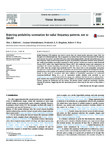Rejecting probability summation for radial frequency patterns, not so Quick!
| dc.contributor.author | Baldwin, Alex | |
| dc.contributor.author | KANG, JUNGHEE | |
| dc.contributor.author | Kingdom, FAA | |
| dc.contributor.author | Hess, RF | |
| dc.date.accessioned | 2017-11-16T17:34:04Z | |
| dc.date.available | 2017-11-16T17:34:04Z | |
| dc.date.issued | 2016-05 | |
| dc.identifier.issn | 0042-6989 | |
| dc.identifier.issn | 1878-5646 | |
| dc.identifier.uri | http://hdl.handle.net/10026.1/10188 | |
| dc.description.abstract |
Radial frequency (RF) patterns are used to assess how the visual system processes shape. They are thought to be detected globally. This is supported by studies that have found summation for RF patterns to be greater than what is possible if the parts were being independently detected and performance only then improved with an increasing number of cycles by probability summation between them. However, the model of probability summation employed in these previous studies was based on High Threshold Theory (HTT), rather than Signal Detection Theory (SDT). We conducted rating scale experiments to investigate the receiver operating characteristics. We find these are of the curved form predicted by SDT, rather than the straight lines predicted by HTT. This means that to test probability summation we must use a model based on SDT. We conducted a set of summation experiments finding that thresholds decrease as the number of modulated cycles increases at approximately the same rate as previously found. As this could be consistent with either additive or probability summation, we performed maximum-likelihood fitting of a set of summation models (Matlab code provided in our Supplementary material) and assessed the fits using cross validation. We find we are not able to distinguish whether the responses to the parts of an RF pattern are combined by additive or probability summation, because the predictions are too similar. We present similar results for summation between separate RF patterns, suggesting that the summation process there may be the same as that within a single RF. | |
| dc.format.extent | 124-134 | |
| dc.format.medium | Print-Electronic | |
| dc.language | en | |
| dc.language.iso | eng | |
| dc.publisher | Elsevier BV | |
| dc.subject | Form | |
| dc.subject | Integration | |
| dc.subject | Radial frequency | |
| dc.subject | RF | |
| dc.subject | SDT | |
| dc.subject | Shape | |
| dc.subject | Signal Detection Theory | |
| dc.subject | Summation | |
| dc.title | Rejecting probability summation for radial frequency patterns, not so Quick! | |
| dc.type | journal-article | |
| dc.type | Journal Article | |
| plymouth.author-url | https://www.webofscience.com/api/gateway?GWVersion=2&SrcApp=PARTNER_APP&SrcAuth=LinksAMR&KeyUT=WOS:000375967600013&DestLinkType=FullRecord&DestApp=ALL_WOS&UsrCustomerID=11bb513d99f797142bcfeffcc58ea008 | |
| plymouth.volume | 122 | |
| plymouth.publication-status | Published | |
| plymouth.journal | Vision Research | |
| dc.identifier.doi | 10.1016/j.visres.2016.03.003 | |
| plymouth.organisational-group | /Plymouth | |
| plymouth.organisational-group | /Plymouth/Faculty of Health | |
| plymouth.organisational-group | /Plymouth/Faculty of Health/School of Health Professions | |
| plymouth.organisational-group | /Plymouth/REF 2021 Researchers by UoA | |
| plymouth.organisational-group | /Plymouth/REF 2021 Researchers by UoA/UoA03 Allied Health Professions, Dentistry, Nursing and Pharmacy | |
| plymouth.organisational-group | /Plymouth/Research Groups | |
| plymouth.organisational-group | /Plymouth/Research Groups/Institute of Health and Community | |
| plymouth.organisational-group | /Plymouth/Users by role | |
| plymouth.organisational-group | /Plymouth/Users by role/Academics | |
| dc.publisher.place | England | |
| dcterms.dateAccepted | 2016-03-08 | |
| dc.identifier.eissn | 1878-5646 | |
| dc.rights.embargoperiod | Not known | |
| rioxxterms.versionofrecord | 10.1016/j.visres.2016.03.003 | |
| rioxxterms.licenseref.uri | http://www.rioxx.net/licenses/all-rights-reserved | |
| rioxxterms.licenseref.startdate | 2016-05 | |
| rioxxterms.type | Journal Article/Review |


